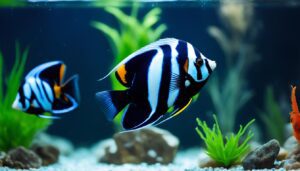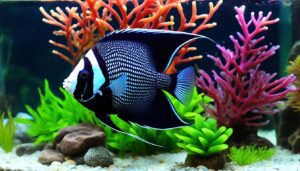I’m excited to talk about Koi Angelfish, a stunning species for any aquarium. They are known for their beautiful, koi-like patterns. These fish live for about 6 to 10 years, so they need long-term care.
Koi Angelfish can grow up to 6 inches long. They need at least a 30-gallon tank to live happily. Keeping the water between 75°F and 82°F, with a pH of 5.8 to 7, creates the perfect home for them.
A well-set-up aquarium needs tall structures and lots of plants. This setup gives angelfish places to hide and swim. They cost some money, but they bring beauty and peace to any room they’re in.
With the right tank care and food, Koi Angelfish will thrive. Breeding them is also fun, with certain steps to follow. Keeping the water warm, between 80°F and 85°F, helps with breeding. I’m here to help you make a great home for these fish.
Understanding the Unique Beauty of Koi Angelfish
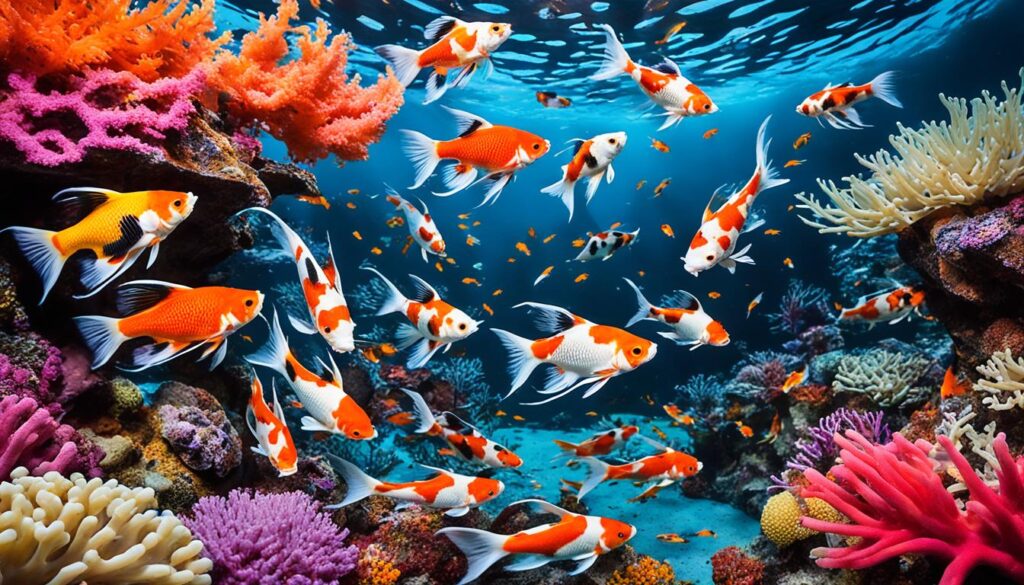
Koi Angelfish mesmerize fish lovers across the globe, being a favorite in the angelfish family. Originating from South America’s lush waters, these Pterophyllum scalare have adapted well to tanks. Their bright patterns and lively nature enhance any aquarium.
Koi Angelfish in the Aquarist’s World
In the freshwater fish hobby, Koi Angelfish stand out with their elegant fins and varied angelfish color patterns. The breeding of different Koi Angelfish types has brought a rainbow of colors to tanks, previously unseen in wild environments.
Distinctive Features: Colors and Patterns
Koi Angelfish are known for their koi-like spots, combining pearl-white and black with orange or gold. Each fish’s pattern is unique, making them living art in aquariums.
Native Habitats: From South America to Home Aquariums
These fish come from South America’s peaceful rivers, belonging to the large South American cichlids family. They’ve gone from wide rivers to small tanks smoothly. The Koi Angelfish is perfect for adding exotic beauty and active engagement to any tank.
Feature |
Description |
|---|---|
Natural Habitat |
Freshwater rivers across South America, dense with aquatic flora. |
Color Variability |
Range from solid silvers to intricate multicolored patterns mimicking the Koi. |
Community Behavior |
Peaceful yet assertive; thrives in species-specific or mixed peaceful fish settings. |
Tank Requirements |
Minimum of 30 gallons with plenty of vertical space to accommodate their tall fin structures. |
Dietary Needs |
Varied diet consisting of high-quality pellets, live foods, and occasional vegetables. |
Whether you’re a dedicated fish keeper or just starting, Koi Angelfish are captivating. They adjust well to tank life and live peacefully with other fish. They’re a perfect choice for anyone wanting to bring natural beauty into their aquarium.
Koi Angelfish: Ensuring Proper Growth and Lifespan
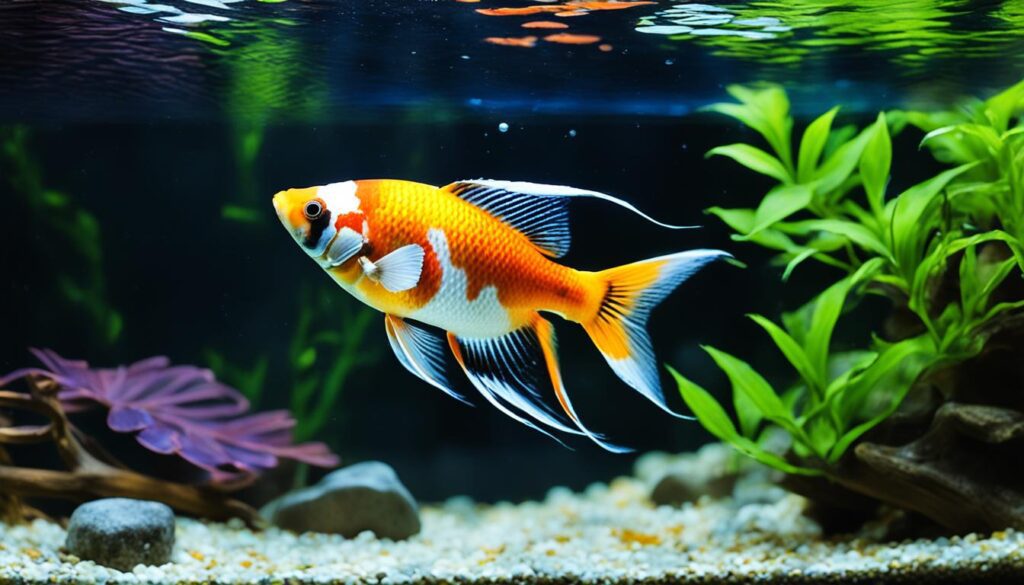
As an avid aquarist, I’ve seen that several key factors affect Koi Angelfish’s growth and lifespan. To keep your healthy angelfish happy, give them clean water and a good diet. Here’s how you can help your Koi Angelfish flourish:
- Optimal Tank Conditions: Koi Angelfish need at least 30 gallons of water each. This prevents overcrowding, supports angelfish growth, and ensures their health.
- Water Quality: Do weekly water changes and keep a pH level between 6.5 and 7.4. This creates a good environment for the angelfish.
- Dietary Requirements: Feed your Koi Angelfish twice daily, and ensure they finish their food in 2-3 minutes. This avoids waste and supports a healthy angelfish diet. Quality food is key to their growth and health.
The right aquatic care also includes careful management of the tank’s community. Keep up to four adult angelfish in a 29-gallon tank with suitable companions. This reduces stress and keeps the tank peaceful.
For a clearer picture, here are the ideal conditions:
Parameter |
Requirement |
|---|---|
Minimum Tank Size |
30 gallons per angelfish |
Water Temperature |
76 – 86 degrees Fahrenheit |
pH Level |
6.5 – 7.4 |
Feeding Frequency |
Twice per day |
By sticking to these tips, your Koi Angelfish can live up to ten years. The dedication to aquatic care and the joy of watching them grow make this hobby very rewarding.
Creating the Ideal Tank Environment for Koi Angelfish
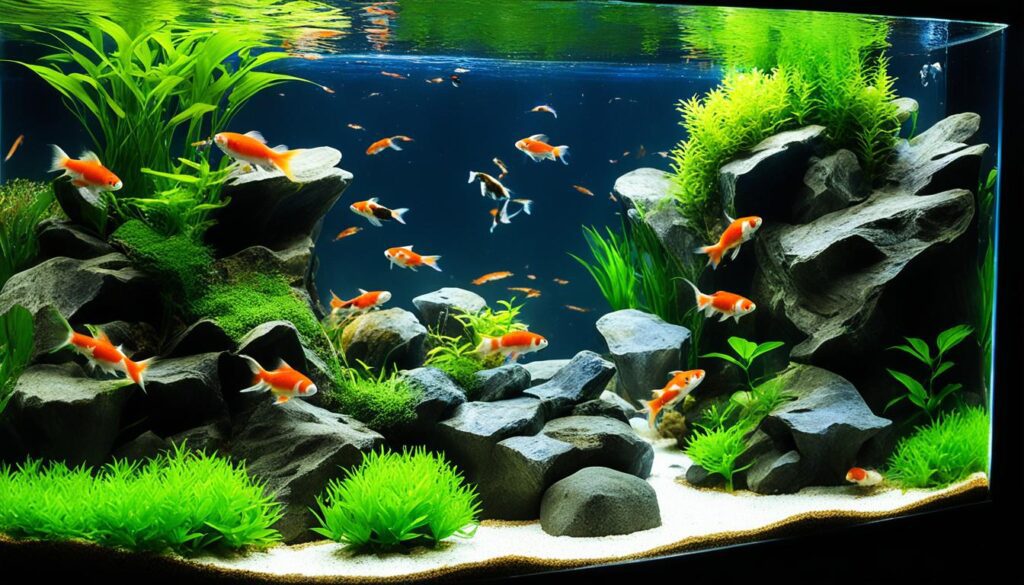
To make your Koi Angelfish healthy, create an angelfish tank setup similar to their freshwater habitat. Start by choosing the correct tank size. A tank of at least 30 gallons is necessary for multiple fish. Bigger tanks are better for space and water quality.
The right water conditions are also vital. Keep the temperature between 75°F and 84°F. The pH level should be from 6.5 to 7.5. Do weekly water changes and use a strong filtration system to keep these conditions.
- Lights: Choose dim LED lights to mimic their shaded natural homes. This also makes their colors brighter without stressing them.
- Plants: Add broad-leaved plants like Java Ferns and Amazon Swords. These plants offer hiding spots and are similar to their natural homes.
- Substrate: Use fine to medium-grade gravel or sand. This looks good and helps their natural behavior.
For setting up your Koi Angelfish tank, here is a table with important parameters:
Parameter |
Optimal Range |
Notes |
|---|---|---|
Temperature |
75°F – 84°F |
Keeping the temperature stable prevents stress and sickness. |
pH Level |
6.5 – 7.5 |
Water that’s slightly acidic to neutral is like their home. |
Water Hardness |
5 – 12 dH |
Soft water is like the Amazon’s water. |
Ammonia & Nitrite |
0 ppm |
It’s vital to have zero to avoid toxic conditions. |
Nitrate |
Low nitrate levels show a healthy and clean tank. |
Being consistent with your angelfish tank setup is crucial. Regularly check and adjust the optimal aquarium conditions. This ensures your Koi Angelfish thrive, just like in their lush natural habitats.
Koi Angelfish: Deciphering the Aquarium’s Space and Conditions
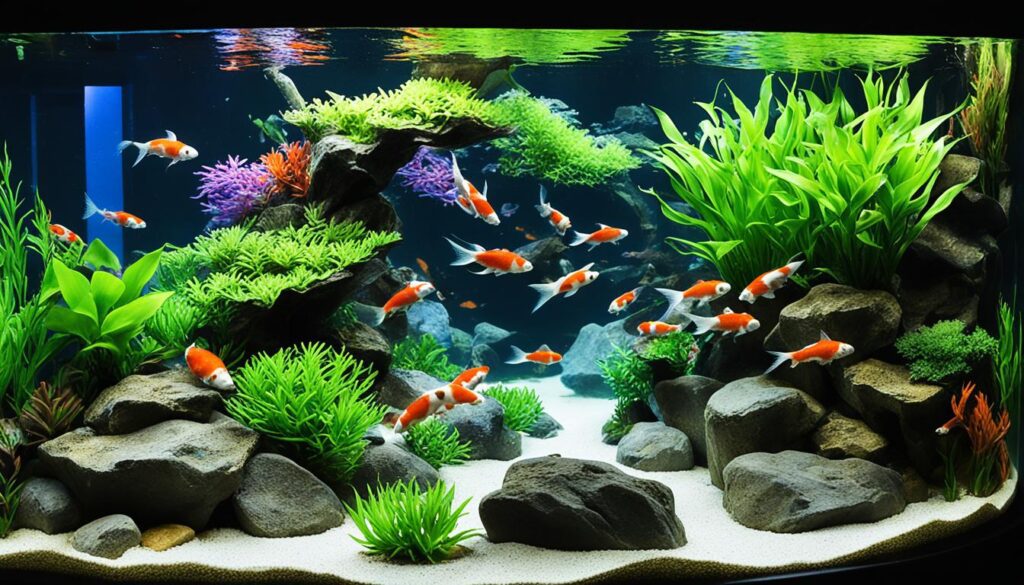
Creating the perfect home for Koi Angelfish means thinking about the right tank size, water conditions, and decor. This helps make their environment as natural as possible. Doing so ensures these stunning fish thrive in your aquarium.
Deciphering Size and Space Requirements
The size of the aquarium size for angelfish directly affects their health and growth. For a couple of angelfish, you should have at least a 20-gallon tank. But, for bigger types like P. altum, you’ll need a taller tank since they can reach up to 13 inches. A spacious tank allows them to move freely and act naturally, which is key to their happiness.
Temperature and pH: Crafting the Perfect Conditions
The correct water temperature and pH balance are vital for angelfish. They thrive in temperatures between 78-86°F and this warmth encourages them to breed. The pH level should be between 6.0 and 8.0, ideally from 6.5 to 7.0. This supports their health. Changing the water regularly, about 20-30% every two weeks, helps keep these conditions ideal.
Aquarium Décor: Elements that Mimic Natural Habitat
For angelfish-friendly decor, consider adding caves, rocks, driftwood, and tall plants. These features do more than look nice. They offer hiding places and spots for breeding, helping your angelfish feel safe and happy.
In conclusion, setting up a Koi Angelfish tank is more than just adding water and fish. It’s about creating a home that mirrors their natural world. By focusing on the right aquarium size for angelfish, keeping the water temperature and pH balance perfect, and adding angelfish-friendly decor, you’re building a vibrant, healthy environment for your angelfish to flourish.
Nourishment: Cultivating a Balanced Diet for Koi Angelfish
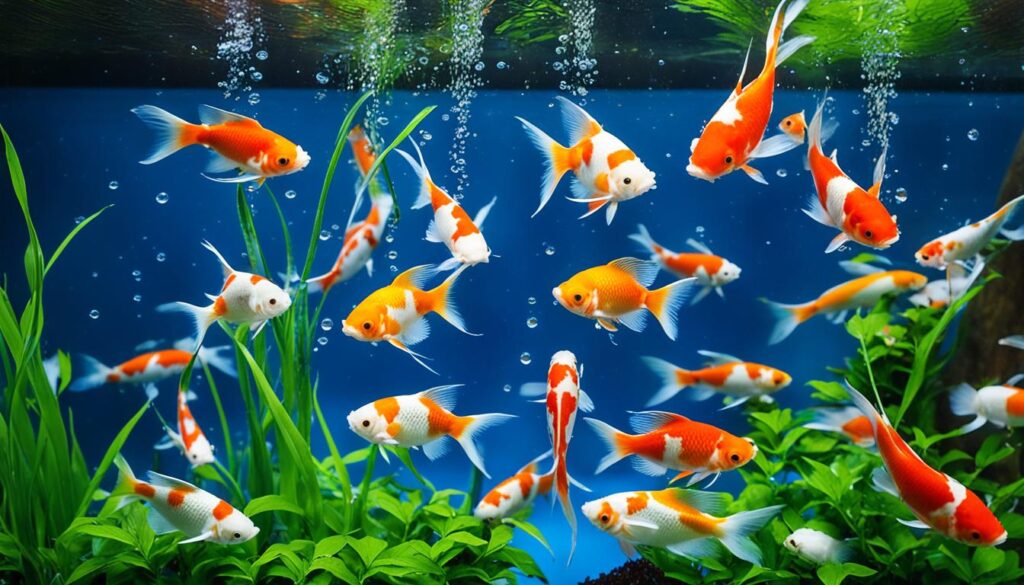
I’ve learned a lot about what angelfish need to eat to stay healthy. For Koi Angelfish, it’s important to have both plants and meat in their diet. Knowing the right way to feed them can make a big difference in their well-being.
I have found a simple, effective way to feed my angelfish. A good diet for them includes high-quality cichlid pellets or flakes. These foods are made to give angelfish all the nutrients they need.
I also give them freeze-dried bloodworms, brine shrimp, and tubifex worms for protein. But it’s not just about treats. Adding these foods is key to their health. Including algae wafers and chopped vegetables makes their diet complete. This mix mimics what they’d eat in the wild.
Food Type |
Benefits |
Frequency |
|---|---|---|
Pellets/Flakes |
Complete nutrition |
Daily |
Bloodworms, Brine Shrimp |
Protein boost |
2-3 times a week |
Vegetables, Algae Wafers |
Fiber and additional vitamins |
2-3 times a week |
If you want to learn more about angelfish food, check out Dean’s guide on Angelfish care. Dean explains how to feed angelfish correctly and create a great tank environment for them.
Always feed your cichlids only as much as they can eat in 2 to 3 minutes. Doing this once or twice a day is enough. Overfeeding can harm both the fish and the water they live in. So, how much you feed them is as important as what you feed them.
To sum up, the right way to feed angelfish involves being careful, offering a variety of foods, and not overdoing it. This method helps them stay healthy and bright. Plus, it helps create a beautiful place for your Koi Angelfish to thrive and show off their natural beauty.
Breeding Koi Angelfish: A Step-by-Step Guide
Starting the angelfish breeding journey is full of exciting moments and detailed care. Once I spot the healthy pairs among the young fish, I focus on making their breeding space perfect. This means setting up a special tank with dim lighting. The water is kept slightly acidic around a pH of 6.5. The temperature is warmed to a cozy 80°F to 85°F to help them spawn. When they pick a spot to lay eggs, my job is to watch closely and keep the tank conditions stable. This ensures a successful breeding.
After the eggs are laid, the challenge to raise angelfish fry begins. Feeding them the right food is crucial. They start with tiny bits of live baby brine shrimp. From up to 1000 eggs, about 300 to 600 fry may survive. Providing the best care and environment is important for each little life. It’s also key to watch out for diseases like dropsy. Keeping the water quality stable is a must. This means regular water tests, tank cleanings, and adjustments.
In my care, angelfish can live for 8 to 12 years with good food and low stress. They do well in a pH range of 6.0 to 8.0. Yet, I pay extra attention to water hardness for their health. Raising angelfish from eggs to adults brings me immense joy. Whether in a 29-gallon tank for the adults or a 55-gallon one for the young, each generation of Koi Angelfish is a sign of my dedication. This involves a mix of science, patience, and knowing what the fish need.

